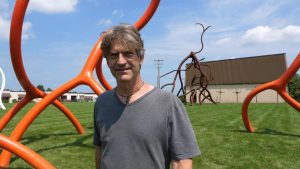What Matters Last
Description
What matters lasts, with Lila Downs, Heather-Dewey Hagborg, Steve Tobin, and Josh Ritter.
Featured Artists

Heather Dewey-Hagborg is an innovative transdisciplinary artist whose work explores the intersection between art and science and raises questions about the ethics of emerging technologies.
Born in Philadelphia in 1982, Dewey-Hagborg studied information arts at Bennington College in Vermont. She earned a masters in interactive telecommunications at New York University and a PhD in electronic arts at Rensselaer Polytechnic Institute.
For her best-known work, Stranger Visions (2012), Dewey-Hagborg collected anonymous DNA (in hair, gum, or cigarette butts) from public places around New York City and analyzed it to generate 3D-printed life-sized portraits representing what the individuals might look like based on their genome. Her work has been shown at the Philadelphia Museum of Art, PS1 MOMA, and venues across the United States and Asia. It is held in the permanent collections of the Centre Pompidou in Paris, the Victoria and Albert Museum and Wellcome Collection in London, and the New York Historical Society, among others.
She teaches interactive media at NYU Abu Dhabi.

Lila Downs is a world-famous singer and actor, known for incorporating indiginous Mexican influences into her popular Latin music.
Downs was born in 1968 in Tlaxiaco, Mexico, and grew up there and in Los Angeles. Her mother was an indiginous Mixtec Mexican; her father was Scottish American. She sings in Spanish, English, and several traditional Mexican languages, and records both original and traditional music. Her lyrics frequently detail the social issues affecting Mexico’s indigineous communities.
She first sang professionally as a child, and gained local popularity in Minnesota in the early 1990s. Returning to Mexico, Downs recorded several albums of traditional music, achieving international success with her fourth LP, La Sandunga (1999). Her rendition of the song “Burn It Blue” from the movie Frida was nominated for an Academy Award in 2002.
She was nominated for a Grammy for her sixth album Oje de Culebra (2008) and won one for her seventh, Pecados y Milagros (2011), which reached number 52 in the Billboard album charts. She received her third Grammy nomination in 2014 for the album Raiz.

Josh Ritter is an admired songwriter and musician known for his lyrical storytelling and Americana folk style.
Ritter was born in 1976 in Moscow, ID. He recorded his self-titled first album while a student at Oberlin College in Ohio, graduating in 1999 with the independent major “American History Through Narrative Folk Music.” The song “Me & Jiggs” from his sophomore record Golden Age of Radio (2001) was a minor hit in Ireland; Ritter’s third album Hello Starling (2003) peaked at number 2 in that country’s album charts. Author Stephen King rated his fourth LP The Animal Years the best album of 2006 in an article for Entertainment Weekly. Two of Ritter’s records, So Runs the World Away (2010) and Sermon on the Rocks (2015) reached number 1 on the Billboard folk charts.
Ritter regularly tours with his Royal City Band, named after a song on The Animal Years. He released his tenth album, Fever Breaks, in 2019. He published a novel, Bright’s Passage, in 2011.

Steve Tobin is an innovative sculptor known for his large-scale artwork inspired by the natural world.
Tobin was born in Philadelphia in 1957. He had his first solo exhibition in 1979, the year he graduated from Tulane University with a BS in theoretical mathematics. He constructed his early artwork in glass, including seven-foot-tall blown-glass cocoons hung in a chapel in Antwerp and a towering waterfall of shards at Retretti Art Centre in Finland. He moved away from glass sculpture in the early 1990s, mortgaging his house to travel to Ghana to make casts of termite mounds that were displayed at Fuller Museum of Art in Massachusetts.
Tobin’s best-known recent artworks are large-scale representations of tree roots. In 2005, he cast an above-ground bronze replica of the root system and stump of a tree that prevented damage to a nearby church during the September 11 attacks. He has had exhibits of his massive steel root sculptures at museums and botanical gardens across North America and in China.
Segments
- Music
- Art & Design
- Music
- Art & Design
Transcript
Coming up on Articulate, sometimes relationships between neighbors can go sour, for the Mexican-American singer, song writer, Lila Downs, there’s much to celebrate in the shared values of her two nations.
Lila Downs: I truly believe in creating songs about these amazing people who in spite of all of this, you know, rise to the occasion and continue being role models for our society.
Everywhere we go we leave behind information about ourselves. Artist Heather Dewey-Hagbor is questioning how our DNA might be used against us.
Heather Dewey-Hagborg: Your data can always so many different stories about you that could be dug into and reconstruired and interpreted to really tell whatever anyone wants to tell about you.
Some people live to push against the edge of possibility. Sculptor Steve Tobin revels in it.
Steve Tobin: In terms of the physics or science behind it I had to make it work and I found a way around the problem.
And much of our shared cultural histories rely on myth making. So too is the music of Josh Ritter.
Josh Ritter: Even if the song itself isn’t durable the themes are durable and they just may be the same story being told in a bunch of different ways, but one of the great things about folk music is that it is completely unruly and there’s all kinds of incredible monsters swimming around in there.
That’s all ahead on Articulate.
Lila Downs’ father wanted her to hear the world. He wanted her to know it.
Lila Downs: I remember, every night, he would have his two Scotch on the rocks. I would make him some eggs, and he would sit down in the living room. He would listen to Miles Davis, maybe Bach sometimes. He would ask me if I read the article in The New Yorker, and we would discuss.
An only child, Downs grew up enriched by the Oaxaca of her Mixtec mother and the Minnesota of her Scottish-American father, and traveling between the two. She was only 16 when her father died. The loss brought hard, essential lessons about identity and female opportunity.
Downs: The white man in the family was gone. And suddenly, in Mexico, especially, I noticed that people kind of would stop addressing me, simply because the man in the family was gone.
AJC: Wow.
Downs: It’s a very serious lesson to learn at that early age. And I think that’s why singing songs about women is important to me, because I find that there are a lot of young women who do not have the same opportunities that young men have. And so, I truly believe in creating songs about these amazing people who, in spite of all of this, you know, rise to the occasion and continue being role models for our society.
In 2002, Downs was nominated for an Oscar for “Burn It Blue,” a signature song from the movie Frida. And though classically-trained, Lila Downs makes music firmly rooted in the Oaxaca culture that she works so hard to preserve.
Downs: I know that the “Cumbia del Mole” for example, the people in Oaxaca now say that they don’t know who wrote it. And I think that’s the ultimate compliment to a composition—that they kind of don’t know where it came from. But it’s their song, and that is the coolest thing.
AJC: So you’ve created a real folk song?
Downs: So that’s a real folk song, yeah.
Downs has also sung about the political tempests of the present day. She’s been an outspoken advocate for those who have gone missing: kidnapped students, disappearing journalists. She has sung out against corruption and, at times, her songs have put her in harm’s way. Through it all she accepts who she is—a women with a dangerous side.
Downs is married to her longtime musical collaborator Paul Cohen. Together, they have an adopted son named Benito, who lives with and between his parents’ two cultures—a multicultural dynamic that echoes the past.
Downs: We just went to Argentina, for example, on tour. And Benito was on vacation, so we brought him with us. And when we left—when we came back on the plane—he cried and cried, and it reminded me of attachment, and letting go, and how that was a big part of my life. And whoever grows up bi-cultural, or tri-cultural, or in different communities, this is inevitable. And it creates this nature of knowing how to let go, which, I think, is a very healthy thing to have in your life. In general, we become attached to so many things and places and people and I thinks it’s a virtue to have that. So I see him go through that and…
AJC: And you’ve been through that.
Downs: And I’ve been through that, yeah.
In 2015, Downs headlined a spectacular Day of the Dead concert in Mexico, producing a lavish show of multiple traditional costume changes and high theatrics. This national celebration has deep personal resonance for Downs, who remembers those who have gone before her with the colors, traditions, and native dishes that have been passed down through generations.
Downs: It’s a profound relationship that you have with your “dead ones,” as we say it.
AJC: Is the joy more unbridled? Is the joy purer in the pre-Christian celebration of the Day of the Dead, do you think? ‘Cause the show you produced certainly was very low on any kind of unhappiness.
Downs: I think it is. I think it’s always about the balance. If you’re going to be a little bit sad, then you must be a little… You must be happy. And if you’re going to remember the dead, then you must drink, and eat, and have a party. It’s always about that balance.
Much of Heather Dewey-Hagborg’s work is grounded in DNA—how it’s analyzed, what it can and cannot predict, and how it might someday be used against you. Her most celebrated work to date, Stranger Visions, is a collection of 3D-printed faces, created using anonymous DNA that she gathered in public places around New York City.
Heather Dewey-Hagborg: Your data can always tell so many different stories about you that could be dug into, re-construed, and interpreted to really tell what anyone wants to tell about you—saying “you’re European,” versus “you’re middle-Eastern,” versus “you’re a Northeast African.” I mean, we’re talking about very tiny differences in probabilities or, sort of, the predictive capacity of any of these things. The whole idea is that you could walk up to this face and be confronted, face to face, with the possibility that your DNA could be used in this way—that someone could pick it up and learn all these things about you, construe all of these things about you in whatever way they chose to. And so I’m hoping that, by using art in this way, it makes it visceral, so you can really feel that vulnerability.
Dewey-Hagborg first awakened to that vulnerability as a master’s student. Her thesis project, Spurious, documented a computer dreaming of faces. The research exposed her to cutting edge facial recognition technology and some disturbing realities.
Dewey-Hagborg: Through kind of digging into these algorithms, and coding them myself, and playing around with them, and seeing what they were good at, and also seeing how they failed— and mostly, how they were not as good as they claim to be or aspire to be—I really began thinking about what it meant for these things to be enacted upon people. What it meant for these to be categorizing people, and looking at people, and providing actionable information about people.
AJC: Right. But we have a presumption of innocence in most freethinking societies.
Dewey-Hagborg: I think that depends on a lot of factors. I mean, some people are privileged enough to get afforded that presumption of innocence, but, depending on who you are, and where you’re from, and the color of your skin, you might not be getting such a presumption.
AJC: If we’re going to be cynical about this we’re talking about somebody making money out of us.
Dewey-Hagborg: Yes.
AJC: And that’s the big objection.
Dewey-Hagborg: I mean…
AJC: It’s certainly one of the big objections.
Dewey-Hagborg: It’s certainly one of them, these companies making all this money off of us. If it’s just us selling our individual data, we’re not gonna make much money off of it. Again, it’s not worth that much on it’s own. But are we okay with these companies or institutions profiting off of us without our permission?
But even though our information isn’t valuable to big companies on its own, we are still in danger of being singled out.
Dewey-Hagborg: It has been shown time and time again that you can quite easily re-identify people that have been supposedly anonymized within these studies. So, thinking about medical data, thinking about genomic data, thinking that really any data that’s supposedly been de-identified, with just a few clues, you can usually re-identify people.
And this threat on losing anonymity is the premise of Heather Dewey-Hagborg’s latest venture, what she describes as a post-genomic love story.
Dewey-Hagborg: T3511 is the mostly true story of a bio-hacker’s increasing obsession with an anonymous saliva donor, whose sample they purchased online. And so it follows this story of buying this sample online, profiling it—a la Stranger Visions, in the beginning. So kind of digging into the DNA, but then also culturing this cells, and discovering more and more about this person. And then, in a kind of turnaround, through using direct consumer services like 23andMe, being contacted by that very person.
AJC: Are these your stories, or are they stories you gathered? Or…
Dewey-Hagborg: I mean, it’s drawn on sort of, mostly my own true story, with a bit of speculation in the mix. I mean, that’s generally the way I like to work, is to kind of take the real, and then just push it a little bit to the speculative edge.
And it is from this vantage point—the speculative edge—that Heather Dewey-Hagborg will continue to explore and to create.
Steve Tobin isn’t afraid to go big.
Steve Tobin: I don’t mind gambling everything on the next piece. At one point, I mortgaged my house to go to Ghana, to make molds of the termite hills, because I wanted to bring them to New York, and juxtapose insect architecture with human architecture, and show the power and sophistication of nature.
Indeed, the ideas that seem most outlandish are usually the ones Tobin pursues. In the early 90s, he set out to make blown glass sculptures seven-feet-tall—despite the fact that this was suppose to be beyond the physical limits of the material.
Tobin: Eventually I did it 15-feet-high, but the scientists at Corning said that the strength of glass would not support itself at that size in the production process. And, in fact, that was quite true. The first 300 pieces I made broke exactly when they said and where they said. But I had built a 22-foot-high building, and ovens 15-feet-long, so I had to make it work. And I found a way around the problem. In terms of the physics or science behind it, glass has a skin, and the strength of the skin would not be strong enough to support the forces on it at that small neck, given the length of the pieces I made. So I took the skin away by keeping the skin liquid. So there was no surface to break—which is really an elegant solution in science, is, if you have a big problem, don’t confront the problem. Find a way to digest the problem into to smaller issues.
AJC: That sounds more like an artist than a scientist.
Tobin: I think that scientists, in many ways, are more creative than artists, because they start with nothing, and they have to define the whole universe. And the difference is they have to make it work, whereas an artist only has to make it work within their own set of rules.
AJC: And beyond the amount of intellect that goes into this, how often are the finished objects a representation of you emotionally, or is that even on the agenda?
Tobin: That’s the most important side. It’s not what I make, but why. And I think that what I do is more rooted in philosophy, and I use process to express it, hopefully in a magical way.
And in some cases that magic has been overwhelming. In the case of Cocoons, shown here in a chapel in Antwerp, Belgium, Tobin says that achievement marked the end of an era for him.
Tobin: That piece transcended any of my ambitions as an artist. It was better than I was. It was something about the context that animated the work. And, after that, I retired from blowing glass because I felt that…
AJC: You’d exceeded your ambitions?
Tobin: Yes.
From there, Tobin began experimenting with scrap glass, creating temporary installations of 40-foot-tall sculptures and 100-foot-long rivers. But it wasn’t long before his career took a hard left turn.
Tobin: So after I did the glass rivers, and I did the cast glass, I felt that I was done with the material. That, by sticking with the material, then the material is dictating the aesthetic too much, and the characteristics and the process associated with it. I felt that, to understand myself, what I was doing, I had to leave the material. My work is not about refining. It’s more about developing ideas and seeing them progress.
From there, Tobin went on to test the limits of his imagination once again—first in bronze, then steel, exploded clay, and, most recently, in wood. But more important than the everchanging how is Tobin’s persistent why.
Tobin: I know how something needs to be made. I know how it’s going to look. Why make it? I don’t know how it’s going to feel. And if I don’t know it’s going to feel, then that’s my biggest motivation to make something.
AJC: And you stand back and you say?
Tobin: Who made this? That’s the result. “Who made this?” It wasn’t me. It wasn’t my assistants. It wasn’t the curator. Who made this?
Steve Tobin believes he is making art for the ages—art made not to represent himself or the time he’s living in, but a universally human narrative.
Josh Ritter tells stories of the epic, the strange, the mundane. …Of a love affair between a mummy and an archeologist.
He opens his eyes
Falls in love at first sight with the girl
In the doorway
With beautiful lines, how full of the life
After thousands of years
What a face to wake up to
…Of an unruly teenage girl getting sent to Bible school in Missouri.
Mama got a look at you and got a little worried
Papa got a look at you and got a little worried
Pastor got a look and said, “ya’ll had better hurry
Send her off to a little bible college in Missouri.”
And now you come back, sayin’ you know a little bit about
Every little thing they ever hoped you’d never figure out
Eve ate the apple, ’cause the apple was sweet
What kinda God would ever keep a girl from getting what she needs?
…Of a Naval arctic expedition, ending in the destruction of the ship for firewood?
As the frost turned her moorings to nine-tail
And the wind lashed her sides in the cold
I burned her to keep me alive every night
In the loving embrace of her hold
And I won’t call it rescue
Ritter’s myths and legends are fictional, but not false. Indeed, he says he’s always been intrigued by the stories that make up our shared heritage. He even created his own major in college, calling it American History Through Narrative Folk Music.
Josh Ritter: I got a taste of how broad the spectrum of musical experience is in this country. That we have so many stories that we have told ourselves with songs, and that is important to realize—that, no matter how much everything is glitzy, and glamorous, and onto the next thing, we are all part of a unbroken chain of music and shared experience that goes back all the way.
But in order to fully embody music, sometimes Josh Ritter has to leave it behind. When he needs a creative cleansing, he turns to painting and writing to re-center and freshen his perspective.
Ritter: Sometimes you have to go someplace else and remind yourself that what you’re doing is supposed to be fun. And painting is that place for me, and writing. They shut down the part of my brain that says, “This has to be perfect,” and they say, like, “This is just gonna be two hours. I’m going to relax. I’m not gonna think about anything.” And I don’t feel like I have to be good at it.
AJC: There’s a lovely quote about you about you, about how you regard the various different arts that you make. You kind of fill up a bucket of stuff, and that runs off.
Ritter: Mm-hmm.
AJC: And some of it becomes songs, some part of it became a novel.
Ritter: Yeah.
AJC: And now some of it’s becoming a painting. Is it all the same stuff though?
Ritter: There’s something that I like to…Mark Twain once said, about the past, that it doesn’t repeat itself but it does rhyme. And I feel like there’s a correspondence there, with all kinds of artistic work that you’re doing. There are baseline preoccupations with huge problems in life and big questions. I think I can come out, and you know, in various ways—whether it’s painting, or words, or music—but it all comes from that same kind of deep well.
Ultimately, though, music is Josh Ritter’s primary artistic tool. It’s a salve for loneliness, when life’s uncertainties make themselves all too apparent.
Ritter: Art is proof that somebody else out there thinking what you’re thinking, or asking the questions you’re asking. And it’s really, really nice, during lonely times, to see somebody else asking the same questions, whether that’s on stage, or in a movie, or in a book, the magazine, on the radio.
AJC: Sharing your misery.
Ritter: Sharing your misery, sharing your questions, like, sharing, also, your optimism, and your hope, and your belief that, you know, when it gets down to it, we’re all gonna be there for each other.

